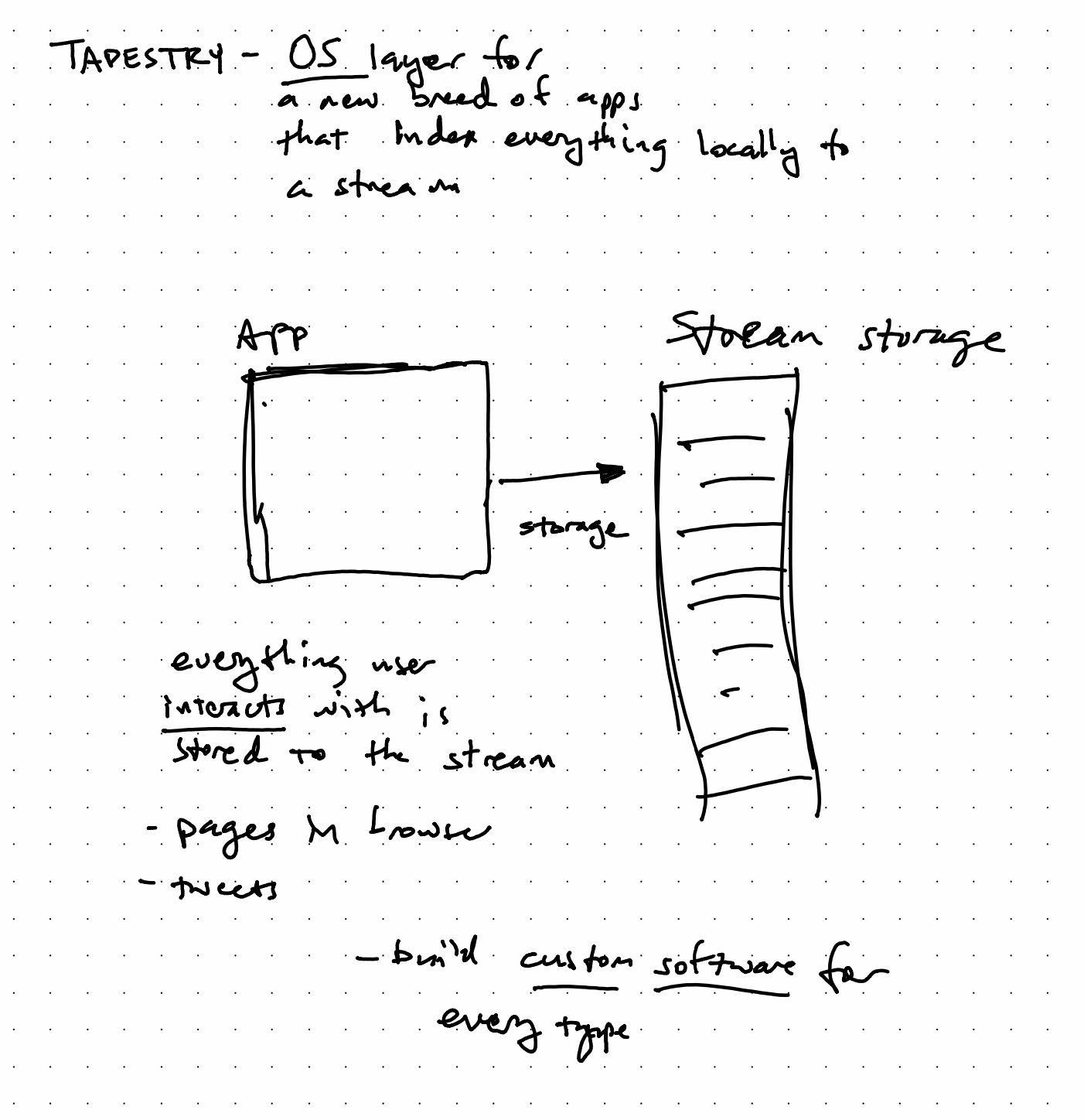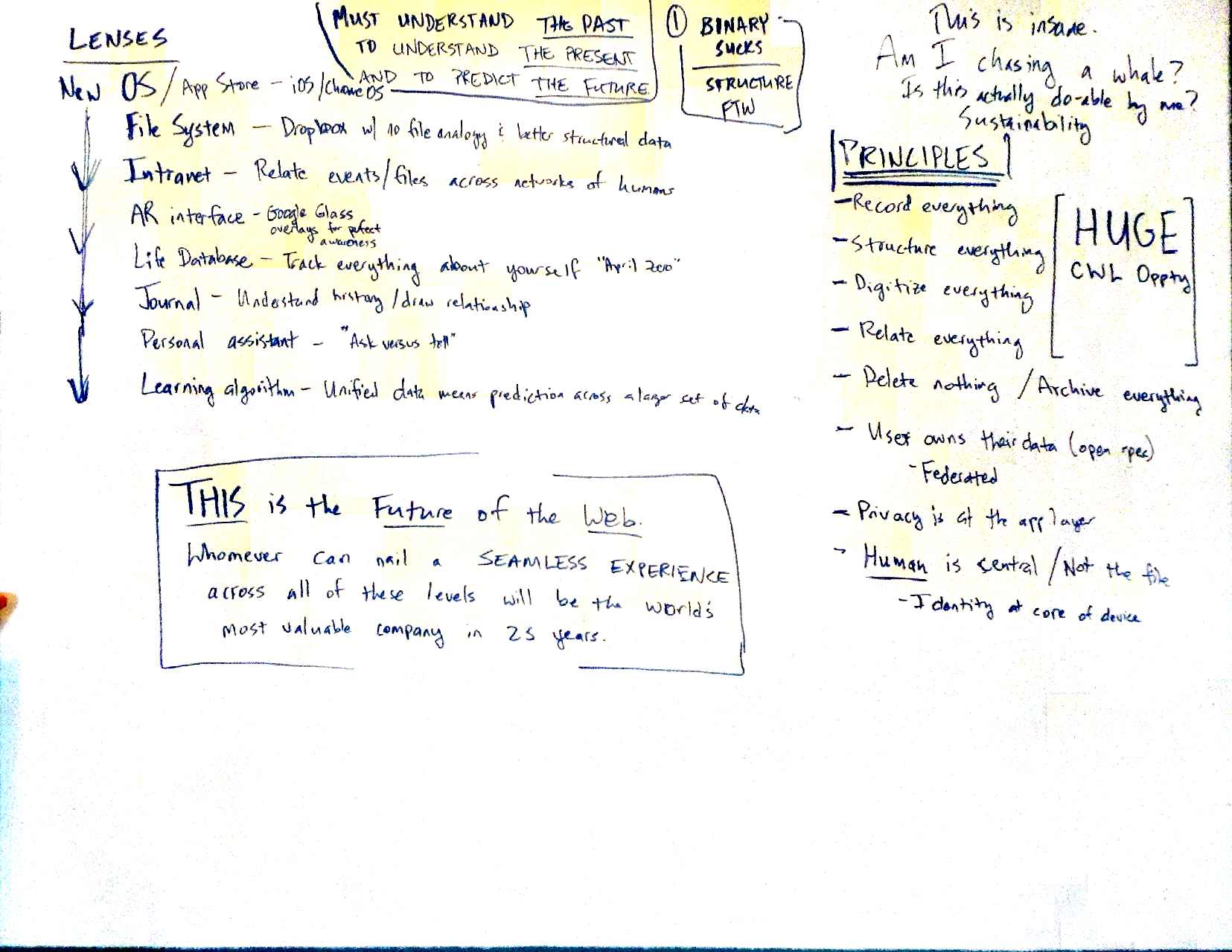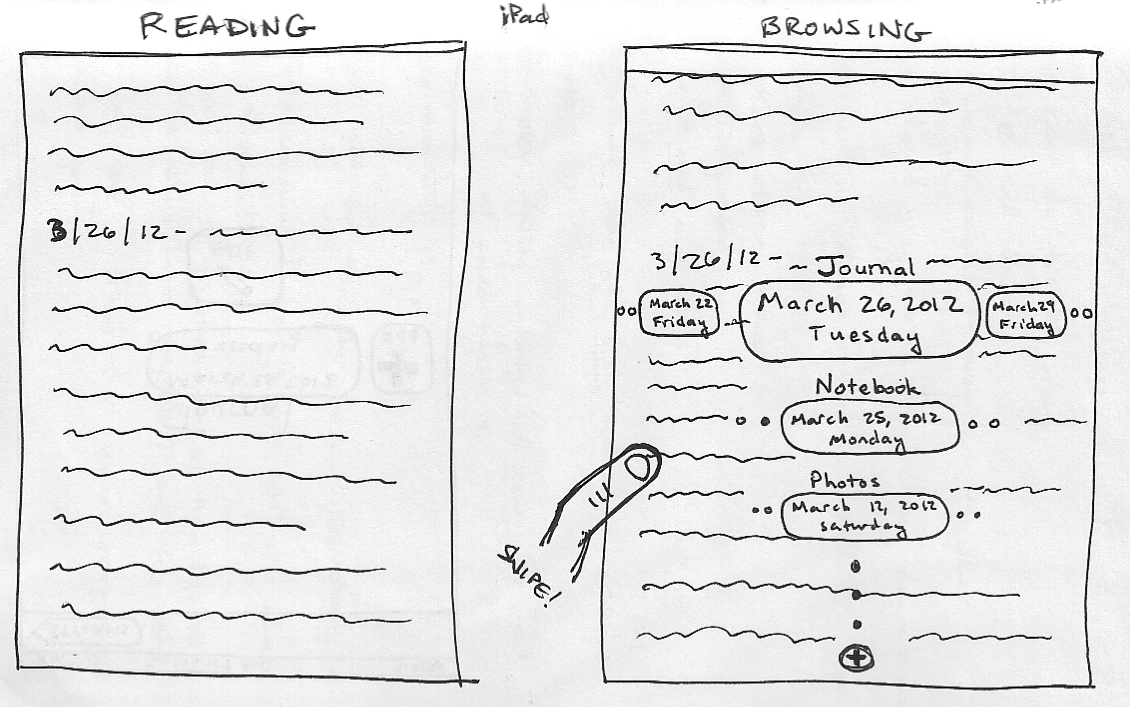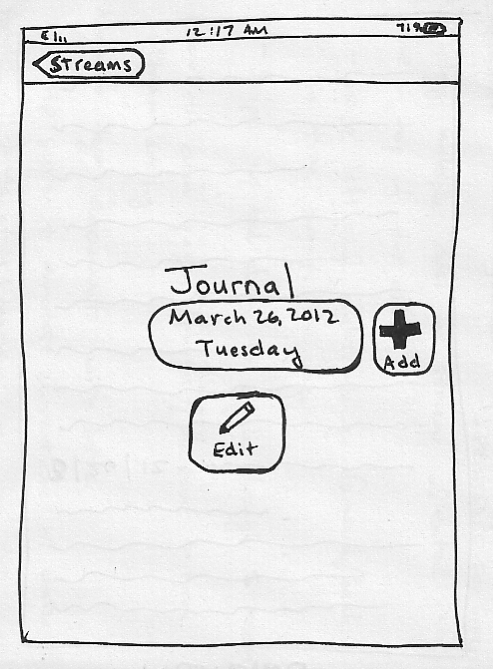Tapestry Proposal
7/14/2021
8/20/2013
"We shape our tools, and thereafter, our tools shape us." - Marshall McLuhan
A proposal for a timeline-based interface for organization, collection and exploration.
Observations
- Our experience of the world intrinsically occurs in time.
- All of our lives consist of various experiences, only some of which have an accompanying digital form. This includes documents written, photographs taken, movies watched, tweets tweeted, source code written, books read, conversations had over coffee, sketches drawn, notes taken on a whiteboard, lectures attended, even chance meetings on the street.
- Experiences that occur near to one another in time are inherently related, though often not in ways we are able to reflect on or discover.
- Our memory is oriented naturally around events that happen near one another on our own personal timeline.
Current Interfaces
Our current computer interfaces rely on 3-dimensional, physical metaphors for organization and storage. These metaphors include files, filing cabinets, folders, and labels.
Benefits of Current Interfaces
The physical metaphor is pretty good at organization for the purpose of long-term storage. It's familiar and comfortable, since we are used to operating in and interacting with the physical world.
Limitations of Current Interfaces
However, the physical metaphor inherently removes our experiences from their setting in time, thus destroying valuable relationships between that experience and the experiences that occur near it.
Difficulties in Collection
Physical metaphors limit the kinds of things that we can even think of storing. Where does a tweet belong in a file system? How do we store a meeting at a coffee shop? What category does watching a movie fall into?
Difficulties in Organization
We spend a lot of time organizing our digital assets because we have to do the physical equivalent of assigning a category, choosing a place to put it, and taking an action to put it there. Anyone with even a reasonable amount of digital stuff will attest that much time is required to keep it all organized.
Difficulties in Exploration
-
Physical metaphors place arbitrary restrictions on the exploration of our experiences. Due to the physical nature of the files and filing cabinet metaphor, to quickly examine experiences of a different nature that occur near one another in time, one has to perform the physical equivalent of opening multiple drawers on a filing cabinet and sorting through the items in each drawer, scanning the items for the date at which they were created, then placing the items from the various drawers next to one another to compare.
-
We have a variety of user interfaces for exploring the different kinds of content we create. Each of these interfaces is specifically tuned to the nature of the content. For example, iPhoto for viewing images is a radically different interface from our daily calendar, which is yet again different from our twitter stream. However, we have no unified meta-interface for exploring all of our experiences. The closest thing we have now is the file system.
Opportunities for a Timeline-based Interface
The death of the file system
- mobile and tablet sales increasing - no notion of a file system
- Chrome OS
- more people using web applications and browsers than desktop applications
The rise of the API
- All our datas belong to us
- Increasingly, our experiences are being captured digitally and the data is programmatically available to us
Intelligent defaults for organization
- Streams of experiences embedded in time eases the burden of organization because categorization can happen automatically
New technologies handle change better
- I'm thinking of git, datomic, and other things that give us infinite version control and intelligent diffs
Towards A New Interface
TBD
Physical Documents - A First Use Case
This is such a radical shift that we need to simply start somewhere and see how the interface develops as we use it. I propose starting with the case of physical documents.
I imagine an application called Tapestry. The name comes from weaving together multiple "streams" or "strands" of information so that a larger picture emerges.
My immediate needs are that I have a lot of physical documents that I'm currently scanning in and I'm disappointed with the ways to organize and explore them. I have journals, usually one personal and one work journal at any given time, and documents that were sketched or written. So a single day may have a personal journal entry, a work journal entry, and one or more documents. Exploring the relationship between these entries is so cumbersome as to make it impractical. Currently, each journal is stored in one large PDF file, and the documents are stored as individual PDFs.
Time
I imagine an interface where each "stream" flows from left to right, with to the left being back in time and to the right being forward in time.
Streams
In my case, the personal journal would be a stream, the work journal would be a stream, and sketched documents might belong to a stream called "Sketches", while written documents would be yet another stream. But really, it's up to the user how to define the streams.
Dates
I imagine each "page" of each document being tagged with the date that it was created. Currently my journal entries are all dated, but some of my documents it's not clear exactly when it was created. I'd love to be able to be fuzzy about dates, specifying year, month, and day (and time?) in increasing order of precision. If I can only get it narrowed down to the month, that's OK.
Tagging with a date should be a very quick and intuitive process. I'm open to suggestions for this interface.
Switching Between Streams
It should be simple to switch between two streams, so I imagine an interface where swiping up or down would show an overlay of all of the stream titles, allowing the user to drag up or down to the stream they wish to select and release. When switching to a new stream, it should default to displaying the entry closest in time to where the user was in the previous stream.
See the reading-and-browsing sketch for a little more detail.
Adding Entries
Ideally, it would be very easy to add entries to the interface. See the add-item sketch for one idea. This needs to be better fleshed out.
Other Content Types
I believe this interface would be extendible to a wide variety of content types, including even markdown documents, photos, etc. Information that could be gathered via API would be particularly easy to populate, but often I feel that information available via API is the least important or impactful, it just happens to be the easiest.
Platform
I see this naturally as an iPad, iPhone or Mac application. Most likely native. But I could be convinced that it could or should be a web application.



